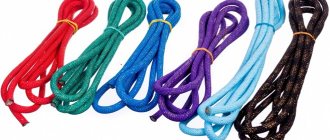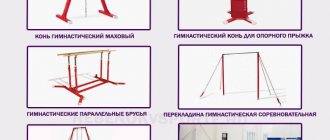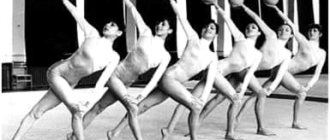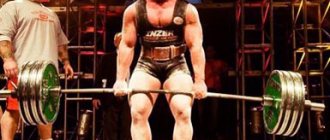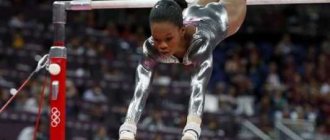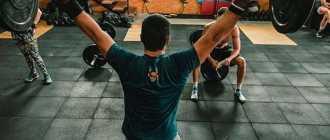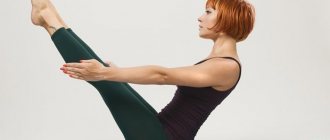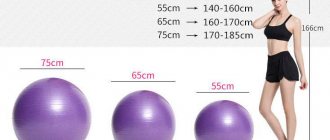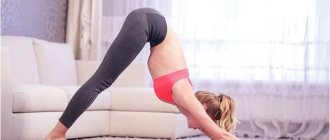Every athlete who practices rhythmic gymnastics knows perfectly well that correctly selected equipment for a given sport means half the success in competitions. As a rule, training for beginner athletes begins with an introduction to rhythmic gymnastics apparatus. The coach will tell you and explain how to choose the right equipment for training, established by the Gymnastics Federation.
In rhythmic gymnastics the following are used:
- jump rope;
- maces;
- ribbon;
- hoop;
- ball for rhythmic gymnastics.
Having learned how to choose the right ball for an athlete, you should turn your attention to the impeccably high-quality and inexpensive products of the Japanese brands sasaki and chacott, which have been successfully used by athletes all over the world for many years.
Which ball for rhythmic gymnastics will be better?
Absolutely all sports require the purchase of additional equipment, special clothing, shoes, and various accessories. Rhythmic gymnastics is no exception in this regard.
If your child decides to start attending weight training. gymnastics, then he will definitely need to buy certain sports equipment. These are: a jump rope, a hoop, a ribbon, clubs and, of course, a special ball. It is worth noting that correctly selected items from this list increase the chances that a young gymnast will be able to achieve better results in her chosen sport. Good coaches, already at the first introductory lesson, tell the parents of the future athlete about how to choose the right sports equipment. In this article we will share information on how to select balls used in rhythmic gymnastics.
Types of fitballs
There are several types of simulators. Therefore, before choosing a fitball, you need to understand the characteristics of each type. Initially, all simulators are divided into categories of diameter, stiffness and type of construction.
By type they distinguish:
- With spikes or gymnastic massage ball.
- With horns (handles) - for additional balance. Basically, such models are considered for children.
- Smooth is a universal type, the most popular in sports.
- "Peanut" - suitable for strength sports and for recovery from injuries.
In most cases, a smooth ball is suitable as it is the most versatile. A gymnastic massage ball is better during rehabilitation (it creates an additional massage effect during work) and also when fighting cellulite, when you need to tighten the skin and break down fat deposits.
How to choose the right ball
So where should you start? By assessing the quality of the material from which such a ball is made. Typically, the highest quality rubber, a special rubber alloy or other materials that are close in their characteristics to traditional rubber are used for this purpose.
Plastic balls and products of not the best quality are allowed for use only during the first steps in the world of art. gymnastics In the future, you should definitely take a closer look at good, professional options.
If possible, it is recommended to purchase gymnastic balls from the Japanese brand Sasaki. They are made from truly the best materials. In addition, the products of this company have another advantage - the balls have a special “sticky” coating, which makes it easy to hold the product, even if it is large. Agree, it’s not very pleasant when a ball suddenly falls out of a gymnast’s hand during a perfectly executed performance. But with Sasaki products this almost never happens.
The brand known as Chacott offers equally high-quality products.
But the choice of color for the ball is usually of secondary importance - each gymnast chooses this characteristic at her own discretion. And today there are a lot of options on offer! These include glossy balls and products with glitter; you can even buy a very impressive chameleon ball.
The next step in making the right choice is to take into account the physical data of the gymnast for whom you plan to buy a ball.
What is a fitball and what is it for?
A gymnastic ball is the simplest type of universal exercise equipment. It is suitable for many exercises and can be used as a main element or as a simulator that complicates the movement. Made from durable rubber material that can withstand enormous loads. The fitball is inflated with ordinary air, which, with the exception of incredible strength, makes it similar to balloons.
Read more about exercises on a fitball →
The main directions in training with fitball:
- Strength training (only with your own body weight, no weights).
- Gymnastic movements.
- Yoga exercises and static positions.
- Recovery and rehabilitation.
This wide range of capabilities makes the large fitness ball a completely versatile exercise machine that is suitable for any training purpose.
Choosing a gymnastic ball according to the age and height of the athlete
In order to select the ideal gymnastic ball, it is necessary to take into account such important parameters as the athlete’s age, her height, the size of her palm, and the class in which the girl is currently performing.
If the age according to the table approximately corresponds to the growth of gymnastics, then you should usually focus on the following recommendations:
- Until the age of nine, gymnasts use the fifteen-centimeter version.
- Between the ages of nine and eleven years, the size of this projectile increases to seventeen centimeters.
- Finally, after celebrating her eleventh birthday, the gymnast should switch to balls whose diameter is eighteen and a half centimeters.
- At the age of fifteen, the dimensions of the gymnastic apparatus no longer change, but on the ball itself there must be a special inscription - FIG Approved. Its presence guarantees that the ball is manufactured entirely in accordance with the standards accepted in world gymnastics, which means that it can be used in absolutely any competition, including international ones.
After determining the dimensions, you can move on to the weight of the ball. It depends on age, as well as on the class in which the girl performs:
- Juniors under the age of nine. The weight of the ball should be 300 grams.
- Juniors under the age of eleven. The weight of the product increases to 350 grams.
- Class “Standard” (age from eleven years) - the projectile must weigh four hundred grams.
Well, at the end, you should definitely let the gymnast try to hold the ball in her hand - make sure that it matches the size of her palm. Based on the last nuance, we can conclude that it is advisable to buy gymnastic balls in the presence of the person for whom they are being taken.
Pattern of size selection
How to choose the right fitball size based on your height:
- With a height of up to 155 centimeters, it is better to choose the diameter of the fitball in the range from 45 to 55 centimeters.
- For a person between 155 and 170 centimeters, the diameter of the gymnastics ball should be 55 centimeters.
- Height from 171 to 185 centimeters implies the use of a fitball with a diameter of 65 centimeters.
- With higher growth, the diameter should also be larger - from 75 to a maximum of 95 centimeters.
When choosing by height, you can approach the question of the size of the ball this way: subtract one meter from the person’s height - this will be the approximate size of the ball. But in principle, you can adapt to the existing ball, you can also choose the size for a specific exercise, which is especially important in therapeutic gymnastics, when a certain angle of inclination or a certain effort is needed. You also need to take into account weight - for people who are overweight, choose the right fitball from more durable rubber that can withstand up to 300 kilograms.
How to choose the right size based on the length of the arm from the shoulder joint to the tips of the extended fingers
- up to 55 centimeters - size from 45 to 55 centimeters
- from 56 to 65 centimeters - respectively, the diameter of the fitball is 55 centimeters
- length from 66 to 75 centimeters - the diameter of the ball is 65 centimeters.
Newborns are given different balls 45 - 75 centimeters in size, but, not surprisingly, it is better to choose a larger ball; it is safer for the baby, because it has a “flat” surface and is more stable, making it easier to hold the child on it.
How to care for a gymnastic ball yourself
Many athletes get so used to their personal equipment that they really don’t want to change it to new ones. Therefore, it is very important to be able to properly care for a gymnastic ball so that it retains its original condition for as long as possible.
Recommendations that should be taken into account in this case:
- The gymnastic ball must be inflated. That is, from time to time you will have to use a special pump to add air to it.
- When cold weather sets in, it is recommended to move the ball into an insulated case if the equipment will be moved outdoors or in unheated rooms. As an alternative to such a cover, a regular hat of sufficient size, made of natural wool, is perfect.
- Exposure to ultraviolet radiation is contraindicated for such a projectile, so you should not leave the ball in places where it may come under direct sunlight.
The athlete must have a protective cover for the gymnastic ball. It is this that will protect the sports equipment from cold weather, sunlight, and possible damage to the surface if careless contact with some other objects occurs.
It is important to understand that even creating ideal conditions for a gymnastic ball does not mean that it will serve its owner forever. For example, even such a reputable brand as the Japanese company Sasaki provides only a two-month warranty, and the shelf life does not exceed one year.
Where are they used?
The use of a projectile is becoming increasingly popular. Invented by a Swiss doctor for the prevention and rehabilitation of patients with cerebral palsy, it has become especially popular in the following types of fitness:
- To strengthen the muscles of the whole body in strength training;
- In Pilates groups;
- Gymnastic for classes and exercises at home;
- Just for some wholesome entertainment.
With such a wide application and variety of its shapes and sizes, it is necessary to select sports equipment taking into account certain parameters.
Advantages of the projectile
Thanks to their characteristics, fitballs have a lot of advantages that are not visible at first glance, but are noticeable during hard training:
- Easy to transport and store (when folded, it takes up almost no space);
- Affects many muscle groups (the entire body is involved in the work, as there is a need to balance);
- Does not require space for classes (a few square meters are enough);
- Improves coordination, strength, endurance;
- Helps in rehabilitation for various injuries;
- Quick preparation of the projectile for work (inflates in a few minutes).
All these, as well as other advantages, make it an indispensable assistant in fitness classes both in the gym and at home.
How to inflate a gymnastic ball yourself
Gymnastic balls are most often inflated on their own. Or they entrust this procedure to the gymnast’s coach, under whose guidance the girl trains. Naturally, this requires a special pump. If a person has a choice, then it is recommended to consider the pump options offered by the same companies Sasaki and Chacott. They allow air to be dosed into the balls, which ensures that they cannot be pumped. In addition, the products of these companies are equipped with needles with a specially rounded tip so that there is no possibility of damage to the nipple.
The very process of pumping up a gymnastic ball can be carried out by following the following instructions:
- Before you begin, you first need to moisten not only the nipple, but also the pump needle with water.
- The needle must be inserted into the nipple at an angle of ninety degrees.
- During air supply, it is necessary to check the product for elasticity.
- A properly inflated ball should be a little soft.
- If by chance more air enters the ball than required, it should be deflated using the capabilities of the pump used.
It is strictly forbidden to use electric pumps for this procedure, which are characterized by increased power. They simply do not allow the necessary level of control, which almost always leads to irreparable deformation of the sports equipment.
Well, one more important rule - such gymnastic equipment should be used only for its intended purpose.
This will allow you to keep it in perfect condition, which is very important both during training and during weightlifting competitions. gymnastics IMPORTANT! Discussion of the topic on the forum at this link - forum.sc-rg.ru
A little history
The fitball was invented by a Swiss physiotherapist who used it for orthopedic rehabilitation of his patients. Subsequently, in the mid-60s, an Italian plastics manufacturer refined this idea, thanks to which the fitball quickly became a must-have accessory in physiotherapy, yoga, athletics and Pilates.
What is another name for large fitness balls? In the West, the term “exercise ball” is often used; in our country, you can sometimes hear fitball called resistance ball or medicine ball, although the older generation knows the latter name as a heavy small ball used in physical education classes.
In general terms, a fitball is a ball made of PVC or other similar non-slippery materials of different sizes (55-75 centimeters). The popularity of this tool is mainly due to its versatility (it can be used for a wide variety of purposes and exercises) and is relatively inexpensive.
Being made of a material that can bend at the point of contact with the human body, this ball turned out to be an ideal tool for those who do aerobics and migrated to fitness centers. So if you are asked what the name of a fitness ball is, you can confidently answer – fitball. Such a ball will fit well into the context of a sports gift for the other half.
Indications for using fitball
- Weight loss
This apparatus has such a large variety of exercises that it is able to use almost all muscle groups, which is why this Swiss machine is quite a popular remedy among those who want to lose weight.
- Preparing for childbirth
Another modern area of application of fitball is prenatal programs that develop flexibility in pregnant women, help increase skin elasticity, develop the pelvic floor muscles, thereby significantly facilitating childbirth and postpartum recovery of the body.
- Retirement age
The Swiss ball is also popular among pensioners: exercise on a large elastic ball helps protect joints and serves as an excellent preventive measure against cardiovascular diseases.
- First years of life
In the youngest children, a fitball can develop coordination, promotes correct posture and is a means of stimulating metabolism. When exercising using a fitball, there is no static load on the legs, which allows you to relieve the musculoskeletal system.
Having a general health effect, fitball is suitable for use by all categories of the population, regardless of age. It is no coincidence that this ball is recommended for activities with infants starting from the age of three months.
This simulator has almost no contraindications: these are people suffering from diseases of internal organs and having herniated intervertebral discs. However, with such diagnoses, any physical activity is contraindicated. The only harm that a large inflatable ball can cause is falls from unprepared individuals, but this is not a problem if the exercise is carried out on a soft surface.
